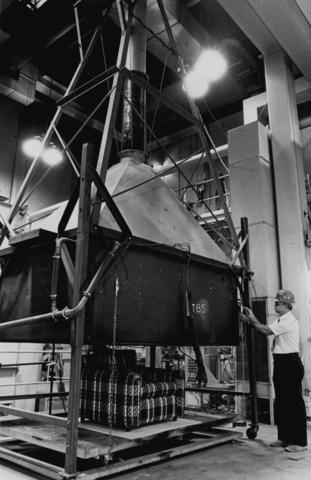Measuring fire size: oxygen consumption calorimetry and the cone calorimeter (1980s)
- Heat release rate is the single most important variable in understanding fire hazard. But it used to be almost impossible to measure.
- NIST discovered that oxygen consumption can be used to measure heat release rate and invented a device, the cone calorimeter, that could make these measurements.
- This research became the basis for fire safety design and commercial product standards around the world.
A fire in a room is not like a campfire outdoors. Even with a relatively small fire, the air in an enclosed space heats up like an oven and can quickly rise to deadly temperatures. But not all things burn equally. Items that burn fast and hot are more likely to cause this oven-like effect.
Take, for example, a 2018 experiment NIST ran on two ordinary upholstered chairs, made with the same foam padding and fabric. They were identical in every way, except that beneath the fabric of one chair the padding was wrapped in a special material called a fire barrier. NIST researchers set both chairs on fire.
The chair without the fire barrier burned rapidly. If it had been in a real room, in less than five minutes the air in that room would have been too hot to survive. But the chair with the fire barrier was a different story. That chair burned so slowly that occupants would have had more than 20 minutes to evacuate.
Experiments like this lead to safer furniture. But running them depends on the ability to accurately measure heat release rate (HRR). And figuring out how to make that measurement wasn’t easy.
Fire scientists first attempted to measure HRR in the 1950s. Those early methods were extremely complicated. The scientists needed a detailed understanding of the chemistry of the thing they were burning and how that chemistry changed as it burned. The tests were inconsistent and difficult to run accurately.
But that changed in the late 1970s, when NIST researchers had a revelation. They didn’t need to know the exact chemistry of the fuel; they only needed to measure the amount of oxygen the fire consumed.
All fires use up oxygen, and NIST research showed that no matter what’s burning, the rate of heat released by a fire is directly proportional to the amount of oxygen taken out of the air. This measurement method was dubbed oxygen consumption calorimetry (OCC), and it was a breakthrough for fire science.

In 1982, NIST staff invented the first device designed for OCC, the cone calorimeter.
This device is designed to heat up a specimen as if it were in a real developing fire. Then as the specimen burns, a hood collects the hot air and measures gas flow, temperature and — most importantly — oxygen concentration.
These data allow the researchers to see how the heat release rate of the burning object changes over time and reveals valuable information, such as whether a fire is likely to spread. Additionally, the cone calorimeter enables small test specimens to simulate burning behavior similar to that of real-scale fires. This allows for the rapid and cost-effective screening of different combinations of padding, upholstery fabrics, and barrier materials, without the need to burn an entire chair or sofa.
There are now more than 300 of these devices in use around the world, the largest of which can be used to measure fires as large as a two-story house.
This groundbreaking research into both the methods and the tools for OCC has been recognized through multiple prestigious honors including two Philip J. DiNenno Prizes as well as the R&D 100 Award. The DiNenno Prize is awarded by the National Fire Protection Association (NFPA) and is considered the “Nobel Prize of public safety,” while R&D 100 Award recognizes the top 100 revolutionary new technologies of the year.
Today, the method and device NIST developed to measure heat release rate through oxygen combustion are widely used by manufacturers and regulators to make safer products, like mattresses, and the research they enable is invaluable for understanding and preventing fires.
Additional Reading:
NIST technical note: An Investigation of the Fire Environment in the ASTM E84 Tunnel Test, 1977.
Journal article: Estimation of Rate of Heat Release by Means of Oxygen Consumption Measurements. Fire and Materials, 1980.
Journal article: Development of the Cone Calorimeter – A Bench-Scale Heat Release Rate Apparatus Based on Oxygen Consumption. Fire and Materials, 1984.
ASTM standard: ASTM E1354, Standard Test Method for Heat and Visible Smoke Release Rates for Materials and Products Using an Oxygen Consumption Calorimeter, 2023.
NIST Online Museum: The Cone Calorimeter: The Most Important Tool in Fire Safety Science, 2023.

